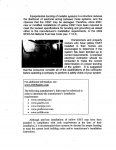wrobotronic
Senior Member
- Location
- Colorado
Hello All,
I am having huge issues with AHJs and other electricians and the need or not need for bonding the gas lines and CSST. The NEC seems to be very contradictory in this regard.
Some electricians are using the #2 Al GEC from the UFER to the gas main line to the water inlet. I was under the impression that this makes the gas pipe a grounding electrode, which is not legal (250.52). Hence I remove it. However, 250.104B states that the GEC CAN be used in this regard. I am so very confused and perhaps I have read so much that I am making it harder on myself.
In the above case, I remove the GEC from the gas main and use the ground in the circuit that supplies the furnace to meet the requirements of 250.104B
The biggest issue I have found is that many get the terms of grounding and bonding confused and tend to use them interchangeably, which can lead to more confusion.
So my question is: Does anyone have a reference with pictures that can explain gas pipe bonding simply and in a straight forward manner? Also, with this regard, the metal gas pipe IS continuous to my circuit ground. So why is there a need to bond, when to me, continuity, or lack thereof, is the need to bond in the first place. I have just lost hope, if I ask 3 inspectors, I get 3 different answers, and the same with electricians. I also have no doubt that my brain is scrambled and I may be confusing this more than needed.
Finally, the POCO says that NOTHING is to be attached to the GAS piping system (and they will remove any such electrical attachments) because of Cathodic charges on the main for corrosion protection, or that the main is poly and attachment is not needed, or there is a dielectric union on the Gas Meter that isolates the system anyway.
To summarize: I do not attach anything directly to the gas pipe and I use the ground in the circuit that supplies the furnace and that should thus make the gas pipe continuous throughout the entire gas system.
I am sorry for the long post, previous posts on this subject were confusing me and I thought a fresh look may help me and others decipher what EXACTLY needs to be done.
Then there is CSST... I think I will wait on that and just tackle the gas main for now...
I am having huge issues with AHJs and other electricians and the need or not need for bonding the gas lines and CSST. The NEC seems to be very contradictory in this regard.
Some electricians are using the #2 Al GEC from the UFER to the gas main line to the water inlet. I was under the impression that this makes the gas pipe a grounding electrode, which is not legal (250.52). Hence I remove it. However, 250.104B states that the GEC CAN be used in this regard. I am so very confused and perhaps I have read so much that I am making it harder on myself.
In the above case, I remove the GEC from the gas main and use the ground in the circuit that supplies the furnace to meet the requirements of 250.104B
The biggest issue I have found is that many get the terms of grounding and bonding confused and tend to use them interchangeably, which can lead to more confusion.
So my question is: Does anyone have a reference with pictures that can explain gas pipe bonding simply and in a straight forward manner? Also, with this regard, the metal gas pipe IS continuous to my circuit ground. So why is there a need to bond, when to me, continuity, or lack thereof, is the need to bond in the first place. I have just lost hope, if I ask 3 inspectors, I get 3 different answers, and the same with electricians. I also have no doubt that my brain is scrambled and I may be confusing this more than needed.
Finally, the POCO says that NOTHING is to be attached to the GAS piping system (and they will remove any such electrical attachments) because of Cathodic charges on the main for corrosion protection, or that the main is poly and attachment is not needed, or there is a dielectric union on the Gas Meter that isolates the system anyway.
To summarize: I do not attach anything directly to the gas pipe and I use the ground in the circuit that supplies the furnace and that should thus make the gas pipe continuous throughout the entire gas system.
I am sorry for the long post, previous posts on this subject were confusing me and I thought a fresh look may help me and others decipher what EXACTLY needs to be done.
Then there is CSST... I think I will wait on that and just tackle the gas main for now...


